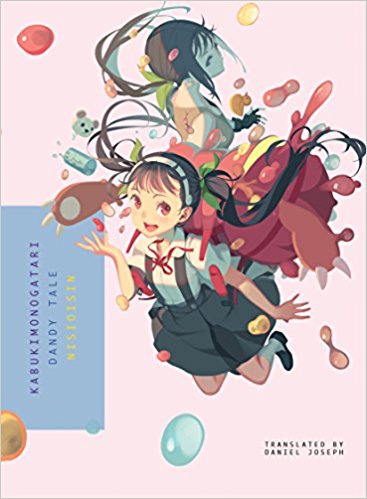By NISIOISIN. Released in Japan by Kodansha. Released in North America by Vertical, Inc. Translated by Daniel Joseph.
The joke about this volume of the Monogatari series has always been that Shinobu steals Mayoi’s book. It’s not entirely correct – the entire thrust of the plot revolves around Mayoi here, and how her state as a ghost wandering the town saddens Araragi as much as it pleases him to banter with her. And of course there’s the climax of the book, which features Mayoi… well, a Mayoi. (Covers always spoil.) But there’s no denying that the actual dialogue in this volume is about 80% between Araragi and Shinobu, as his desire to finish his summer homework (which he had forgotten to do due to college exam prep) leads to Shinobu abusing her powers to send them back in time. This leads to what at first seems like a chance for Araragi to change history so that he can make Mayoi’s life and death a little better… after all, how could saving one little girl from getting hit by a car possibly change history? (cough)
Araragi is once again the narrator of the series, which alas means that we have a lot of his tendencies to deal with. In fact, given that Nisioisin says in the afterword that he was trying to write a novel consisting almost entirely of little girls (Mayoi, Shinobu, and Ononoki, who sets the plot in motion with her discussion of the differences between her, Mayoi, and Araragi), there’s even more lolicon jokes here than ever before, with endless discussion of Shinobu’s ribs and their use and abuse. Fortunately, though, this also means we get the opportunity to evolve Shinobu’s character and make her more proactive. She’s gone from being an outright villain, to sulking, and then to being a somewhat teasing but reluctant partner who says she helps Tsukihi merely because it amuses her. This book shows how much the pairing between Araragi and Shinobu has truly changed both of them, and reinforces the closeness of their bond. Araragi may love Senjogahara most, but he’ll die with Shinobu, and that’s sweet too, in a vampire sort of way.
It might be a good idea, by the way, to go back and read the 3rd Bakemonogatari series, Tsubasa Cat, before tackling this one, as the events there play out here in a tragically different way. That said, Araragi himself has already forgotten what happened that day and has to have his memory jogged by a somewhat frustrated Shinobu. On the other hand, you may want to save your reading time for this book alone, given it’s one of the longer volumes in the series to date. Much of that length is taken up by what we’re used to seeing from Araragi and company – endless meandering conversation, killer untranslatable puns, and 4th wall breaking galore, with discussion of the characters knowing they’re fictional, as well as knowing that they’ve got an anime airing. Anime fans may be interested to know that this one cuts out more than most any other Monogatari adaptation, so it’s worth picking up to see what you missed.
There is also, as you can no doubt see, another translator on the series, and he’s also doing the next book, Hanamonogatari, which will focus on Kanbaru. He does a good job of keeping things as smooth as it’s possible to o given this author’s tendency to vomit dictionaries at people whenever the opportunity comes up. Ononoki is trying out new variations on “oni no onii-chan” here (brogre was a favorite of mine). There are one or two places where the translation suddenly features a lot of Japanese words, and you get the feeling there even the editors agreed “yeah, that’s just impossible to adapt”. Even the subtitle \to the book is tricky. A kabukimono is sort of the equivalent of a Japanese dandy, but it can also mean “twist” or “deviation”, which is certainly what happens here with all the time-travel antics.
Fans of Monogatari will want to pick this up, particularly if they like Shinobu or Mayoi. For anyone feeling bad for Mayoi, given that Shinobu steals the spotlight so much, I’d wait till later in the year when that might change.

